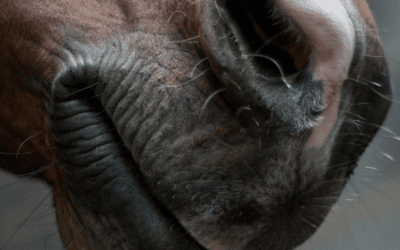Mild-Moderate Equine Asthma
Inflammatory airway disease and recurrent airway obstruction are terms that have been used to describe horses with respiratory signs as a result of lower airway inflammation for many years. Recently it has been concluded that all of these conditions or syndromes can all be characterised as equine asthma. This change in classification has led to some confusion amongst clinicians as to the precise features of each condition and how exactly each differs from the others. The most recent consensus statement on inflammatory airway disease conducted by Couetil et al (2016) aims to clarify this information. It defines equine asthma as a spectrum of diseases that ranges from mild to moderate asthma (mEA) or inflammatory airway disease to severe asthma (sEA) or recurrent airway obstruction.
sEA usually affects horses over the age of seven whereas mEA is thought to affect animals of all ages. Horse’s suffering from sEA are abnormal at rest, displaying an increased respiratory effort and coughing frequently as a result of marked lower airway inflammation and obstruction. In contrast mEA clinical signs are not always as obvious as breathing is usually normal at rest but there is a negative effect on performance and occasional coughing of at least 3 weeks duration. Due to the subtle nature of mEA signs, sensitive diagnostic criteria and a well-defined characterisation is necessary for detection.
Endoscopy and broncho-alveolar lavage (BAL) are commonly utilised diagnostic tests to aid in identification and diagnosis of mEA. Visualisation of tracheal mucus during endoscopy and abnormal pulmonary function tests act as evidence in support of an mEA diagnosis. Mild increases in neutrophils, eosinophils and mast cells in BAL samples confirm the presence of mild lower airway inflammation and are suggestive of mEA.
The aim of this article was to review the body of evidence that supports the consensus definition of mEA and assess its strengths and weaknesses. This research would also help to identify any gaps in the current knowledge and hopefully help to guide future research on the topic.
How was the study performed?
The consensus statement identifies poor performance, cough, tracheobronchial mucus, abnormal BAL cytology and pulmonary dysfunction as the five diagnostic indicators of lung pathology. Articles reporting any of these indicators were searched for and all studies in horses (of any breed, use, age or sex) conducted between January 1987 and March 2021 were eligible for inclusion. This search resulted in 2275 articles being retrieved with 298 full-text articles being reviewed as a result. A total of 45 articles (based on 44 studies) were included in the review. These articles included a variety of study types, the majority of which could be defined as opportunistic observational studies or cross-sectional studies. Thoroughbred racehorses were examined in the vast majority of the studies.
These studies were then quality appraised via examination for risk of bias using the following ten domains; aim, study population, study power, masking, case definition, diagnostic classification, indication of precision, completeness of results, believable conclusions and consistency.
Associations between mEA and the five different diagnostic criteria were examined in these 44 articles. Any associations between pairs of the diagnostic indicators, e.g. cough and BAL cytology, and mEA were also examined.
What were the results of this study?
The results of this study show that there is more conclusive evidence across the studies examined for certain associations compared to others. The evidence for the association between a cough and both tracheobronchial mucus and BAL cytology is consistent but the evidence is less convincing when associations between poor performance and tracheobronchial mucus, poor performance and BAL cytology, and tracheobronchial mucus and lung function are examined.
Conflicting evidence for associations between poor performance and lung function, tracheobronchial mucus and BAL cytology, and BAL cytology and lung function were identified through this study. This suggests that further studies are needed to establish what relationship if any there is between these diagnostic indicators in the case of mEA.
Unfortunately, no studies examined the associations between lung pathology and pulmonary dysfunction, poor performance or cough. The association noted between tracheobronchial mucus and BAL cytology, and the lack of association between BAL cytology and lung pathology, and cough and lung function were only examined in singular studies. Further research is warranted to confirm the findings of these studies.
What does this mean for my clinical practice?
Bronchoalveolar lavage has been a mainstay of equine asthma diagnosis for many years but the data collected from BAL cytology may not be as useful as originally thought. While this review supports the association between a horse having a chronic cough and changes to BAL cytology, it is worth bearing in mind that the vast majority of the studies examining BAL cytology have been conducted in thoroughbred racehorses. BAL cytology reference ranges vary greatly between horses of different breeds and uses i.e. a show jumping Belgian Warmblood will have a different baseline BAL cytology to a thoroughbred racehorse and as such require a different reference range for interpretation of cytology results. Further studies examining the relationship between a chronic cough and changes in BAL cytology in mEA in other populations of horses would be extremely useful for veterinarians treating these animals as the findings may differ from the population examined in the articles used in this review.
A more definite definition of ‘changes in BAL cytology’ would also be useful when interpreting results when treating a horse with chronic coughing. Of the three studies supporting this association, one reported an increase in eosinophilic responses and no neutrophilic response with a cough (Secombe et al., 2015) while another reported the exact opposite (Bedenice et al., 2008). All three studies agreed that coughing horses have decreased macrophage concentrations on BAL cytology but there was conflicting evidence when lymphocytic concentrations were examined. These findings further demonstrate the need for further research into BAL cytology in mEA and more specifically standardisation of the reference ranges used and the exact changes to be expected in association with a cough.
The consensus statement considers a cough of at least 3 weeks duration to be a key baseline indicator of mEA. However, the articles examined in this review did not always define chronic as ‘greater than 3 weeks duration’. Many of the studies simply examined horses with a cough of any duration. Therefore one must consider that some of the evidence supporting or disputing relationships between a cough and other diagnostic indicators of mEA may have been different if the definition of chronic cough had been more specific during the screening phase of the review.
The strong association between the presence of a chronic cough and tracheobronchial mucus in horses with mEA is useful for clinicians in practice. Performing endoscopy on horses presenting with a chronic cough would be a worthwhile exercise for the diagnosis of mEA. Examining for mucus could be performed in conjunction with obtaining a BAL sample for cytology in coughing horses with suspected mEA. The use of a mucus scoring system would also be useful as an indicator of progress in mEA cases. Although tracheobronchial mucus scoring is not as valuable for mEA diagnosis in horses presenting due to poor performance.
Endoscopy and bronchoalveolar lavage are commonly utilised diagnostics to investigate poor performance in equine patients. Different measures of poor performance were utilised in the articles examined in this review for example poorly judged show horses, trainer opinion and race placing. These measures are either very subjective measures (show horse performance) or are influenced by countless other factors (race placing). It could also be argued that other, more objective, measures such as maximal speed achieved and duration of the final step, were examined on treadmills and so this data may not translate into the real-life athletic function of the horse. This makes the data difficult to interpret as there may have been more convincing evidence for associations between poor performance and other diagnostic indicators if another measure of performance was examined. However, this review shows that there is an association between poor performance and tracheobronchial mucus so again mucus scoring is useful when investigating causes of poor performance. The evidence for the association between poor performance and changes in BAL cytology is less convincing suggesting that other diagnostics should be prioritised when investigating horses performing poorly.
Conclusion
This review has offered some good evidence in support of the consensus definition for mild to moderate equine asthma. It has also highlighted the gaps in the literature and called attention to the need for further research to be conducted on equine asthma. Equine asthma is a condition which affects all areas of the equine industry so any further research on this topic would help to greatly improve the welfare and performance of equines.
By Mary-Kate Burke MVB CertAVP PgCertVPS MRCVS




